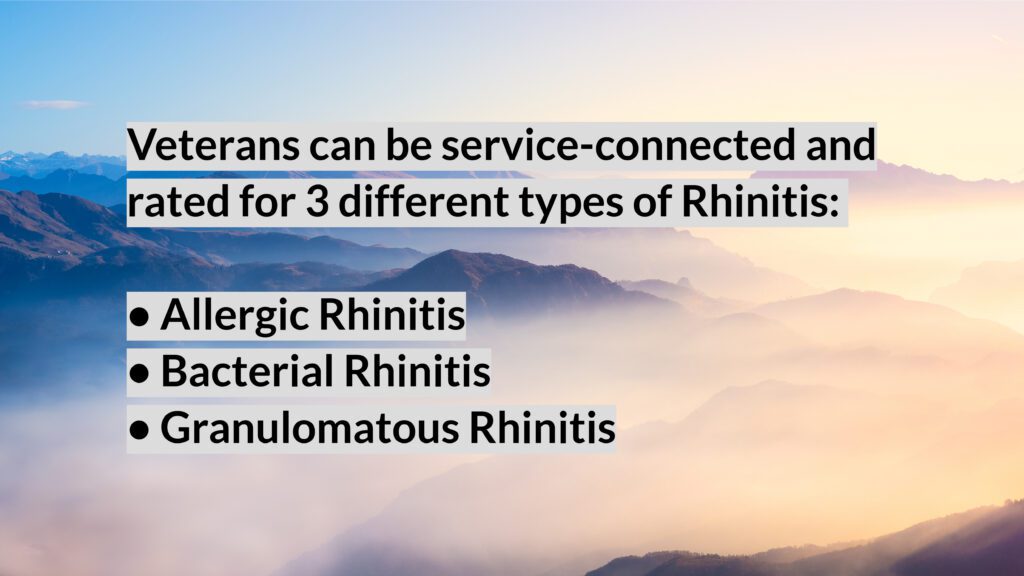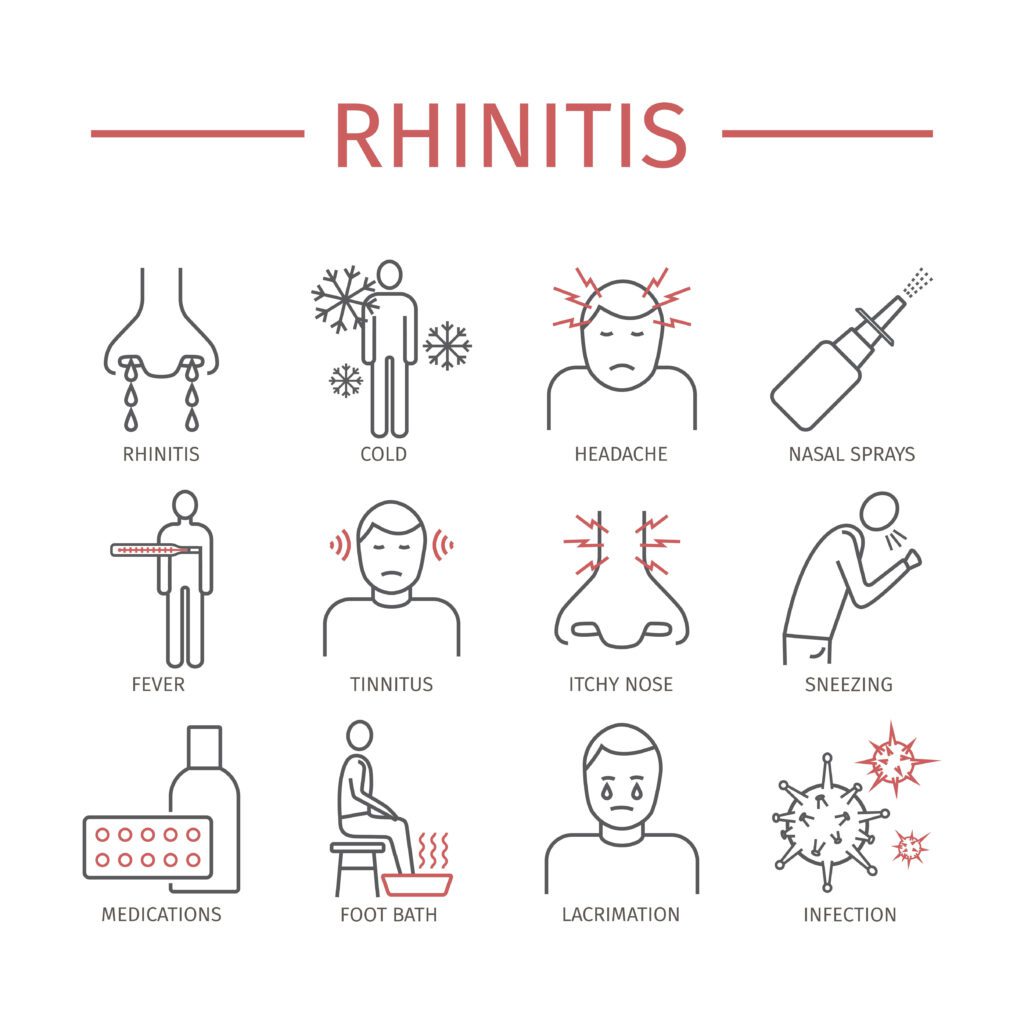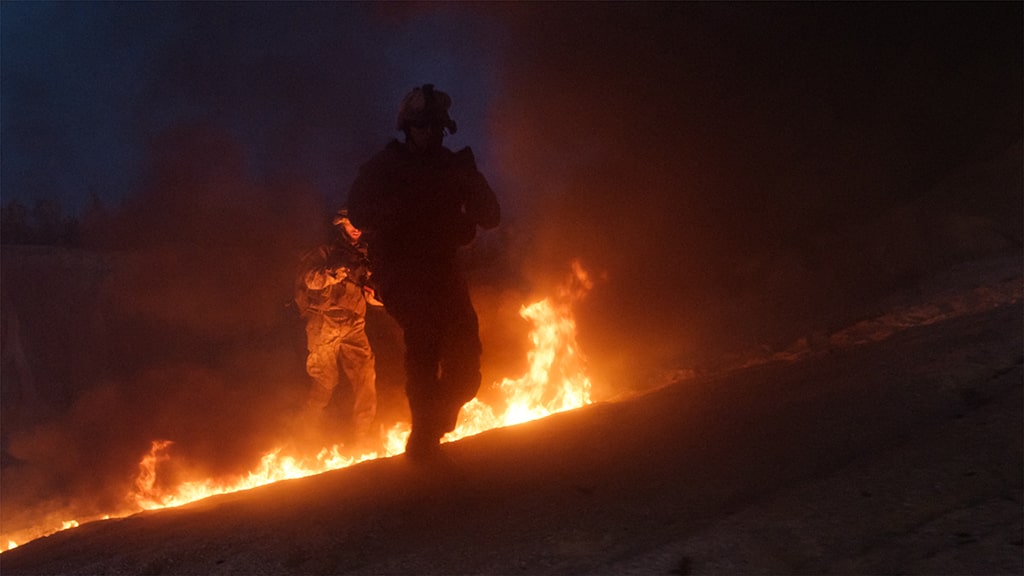Looking for Expert-Level VA Claim Answers?📱Call Us Now! 737-295-2226
Brian Reese here the VA Claims Insider, and in this guide, we’ll explore how to get a VA Rating for Rhinitis, including the top 3 ways to prove your Rhinitis was due to your military service.
Generally, veterans meet the eligibility criteria for “Allergic Rhinitis,” in which case, the VA Disability Ratings for Rhinitis are either 10 percent or 30 percent.
The highest scheduler Allergic Rhinitis VA Rating is 30 percent, which means you have Allergic Rhinitis with Nasal Polyps.
Your final Rhinitis VA Disability Rating depends upon the Frequency, Severity, and Duration of symptoms and any impairment or loss (e.g., work/life impacts).
Guess what else?
Many veterans mistakenly believe the maximum rating for Rhinitis is 30 percent…
Wrong!

There are 3 different types of Rhinitis that can be service connected and rated:
- Allergic Rhinitis
- Bacterial Rhinitis
- Granulomatous Rhinitis
For example, Granulomatous Rhinitis can be rated as high as 100 percent (more on that below).
In addition, veterans who suffer from Allergic Rhinitis have an increased risk of developing Obstructive Sleep Apnea, in which case, you can file a VA claim for Sleep Apnea secondary to Rhinitis.
Okay, let’s explore this Insider’s Guide for getting VA disability for Rhinitis, even if you’ve already filed or been denied.
You DESERVE a HIGHER VA rating.
Take advantage of a VA Claim Discovery Call with an experienced Team Member. Learn what you’ve been missing so you can FINALLY get the disability rating and compensation you’ve earned for your service.
- What is Allergic Rhinitis in Veterans?
- Do I Have Allergic Rhinitis or the Common Cold?
- Common Signs and Symptoms of Allergic Rhinitis (Hay Fever)
- How to Get a Rhinitis VA Disability Rating: Basic Eligibility Criteria
- Allergic Rhinitis VA Rating: Is Rhinitis a VA Disability?
- How Do I Get a Rhinitis VA Rating?
- What is the Reasonable Doubt Rule for Rhinitis?
- VA Rating for Rhinitis: 3 Paths Revealed
- What are the VA Secondary Conditions to Allergic Rhinitis?
- What Should I Expect at a C&P Exam for Allergic Rhinitis?
- About the Author
What is Allergic Rhinitis in Veterans?

Allergic Rhinitis, also called “Hay Fever,” has symptoms similar to the common cold: Runny nose, itchy and watery eyes, nasal congestion, coughing and sneezing, and sinus pressure.
The biggest difference between a head cold and Allergic Rhinitis is that the former is caused by a virus and the latter is caused by allergens.
For example, Allergic Rhinitis is caused by an allergic response to outdoor or indoor allergens, such as pollen, dust mites, or shedding’s by cats, dogs, and other animals with fur or feathers, known as “pet dander.”
Allergic Rhinitis is no laughing matter: It can make your life miserable and negatively impact your work, life, and social functioning.
Do I Have Allergic Rhinitis or the Common Cold?
Here’s a helpful chart to distinguish between the two conditions:
| Condition | Signs & Symptoms | Onset | Duration |
| Allergic Rhinitis | Runny nose with thin, watery discharge and no fever | Immediately after exposure to allergens | Typically for as long as you’re exposed to allergens |
| Common Cold | Runny nose with watery or thick yellow/green discharge; body aches; low-grade fever; cough; stuffy nose, with symptoms worsening at night. | One to three days after exposure to a cold virus | 3 to 7 days |
Common Signs and Symptoms of Allergic Rhinitis (Hay Fever)

According to the Mayo Clinic, signs and symptoms of Allergic Rhinitis include:
- Runny nose and nasal congestion
- Watery, itchy, red eyes (allergic conjunctivitis)
- Sneezing
- Cough
- Itchy nose, roof of mouth or throat
- Swollen, blue-colored skin under the eyes (allergic shiners)
- Postnasal drip
- Fatigue
How to Get a Rhinitis VA Disability Rating: Basic Eligibility Criteria

To be eligible for a Rhinitis VA Rating, a veteran must meet three (3) criteria by law:
- #1. Medical diagnosis of Rhinitis, in a medical record (Service Treatment Records, VA medical records, or private medical records)
- #2. Your Rhinitis was caused or made worse by your active-duty military service OR by another service connected disability for secondary service connection (“Nexus” for service connection)
- #3. Persistent and recurring symptoms of Rhinitis (“Severity of Symptoms”) in terms of Frequency, Severity, and Duration to include any functional impacts.
If you think you have some form of Rhinitis, but don’t have a medical diagnosis, pick-up the phone and call the VA health facility nearest you to make an appointment right away!
If you’re trying to increase your VA rating for Rhinitis, you need to prove to the VA that your symptoms are now worse and warrant the higher rating criteria by law.
The #1 best way to increase your VA rating for Rhinitis is to have objective medical evidence to show your symptoms have worsened over time.
Allergic Rhinitis VA Rating: Is Rhinitis a VA Disability?

Yes, Rhinitis is a VA disability, and it can be rated under one of three possible Diagnostic Codes (DC) depending on your medical diagnosis:
The VA rates Allergic Rhinitis under CFR 38, Part 4, VA Schedule of Ratings, DC 6522, Allergic or Vasomotor Rhinitis, whereas Bacterial Rhinitis falls under DC 6523 and Granulomatous Rhinitis under DC 6524.
Most often, veterans are rated for Allergic Rhinitis at either 10% or 30%.
How Do I Get a Rhinitis VA Rating?

There are 3 primary ways a veteran can get a VA disability rating for Rhinitis:
#1: Direct Service Connection for Allergic Rhinitis with a rating of 10% or 30%. This means an in-service event, injury, or disease related to your military service caused you to develop Rhinitis.
#2: Secondary Service Connection for Allergic Rhinitis with a rating of 10% or 30%. For example, a veteran can be rated for Rhinitis secondary to Deviated Septum.

#3: Allergic Rhinitis “Presumptive” to Burn Pit Exposure with a rating of 10% or 30%. If you served in the Gulf War region during the presumptive period, the VA assumes your Rhinitis is related to burn pits. The presumptive period for particulate matter exposure is Afghanistan, Djibouti, Syria, and Uzbekistan during the Persian Gulf War, from September 19, 2001, to the present, or the Southwest Asia theater of operations from August 2, 1990, to the present. To be eligible for VA benefits, you must have gotten one of these conditions within 10 years of your separation from active duty military service.
What is the Reasonable Doubt Rule for Rhinitis?

The Reasonable Doubt Rule, also known as the Benefit of the Doubt Doctrine, means that the evidence provided by the veteran must only persuade the decision maker that each factual matter is “at least as likely as not.”
This means there’s a 50/50 chance.
When, after careful consideration of all evidence, a reasonable doubt arises regarding service origin, the degree of disability, or any other point, such doubt will be resolved in favor of the veteran.
The courts further likened the reasonable doubt rule as akin to the principle in baseball that the “tie goes to the runner.”
When in doubt, the benefit is ALWAYS given to the veteran.
Independent providers and C&P examiners must consider and give weight to the veterans self-reported symptoms when completing their DBQ for Rhinitis.
VA Rating for Rhinitis: 3 Paths Revealed

There are three possible Diagnostic Codes (DC) and VA Ratings for Rhinitis depending on your medical diagnosis.
DC 6522, Allergic or Vasomotor Rhinitis:
- Allergic Rhinitis with Polyps, rate at 30%.
- Allergic Rhinitis without Polyps, but with greater than 50 percent obstruction of nasal passage on both sides or complete obstruction on one side, rate at 10%.
DC 6523, Bacterial Rhinitis:
- Bacterial Rhinitis with Rhinoscleroma, rate at 50%.
- Bacterial Rhinitis with permanent hypertrophy of turbinates and with greater than 50 percent obstruction of nasal passage on both sides or complete obstruction on one side, rate at 10%.
DC 6524, Granulomatous Rhinitis:
- Granulomatous Rhinitis with Wegener’s granulomatosis, lethal midline granuloma, rate at 100%.
- Granulomatous Rhinitis other(s) with infection, rate at 20%.
Pro Tip: Were you exposed to Burn Pits? If you served in Afghanistan, Southwest Asia or certain other regions and developed Sinusitis, Rhinitis, or Asthma within 10 years from your separation from active duty service, these respiratory conditions are presumed to be service-connected. This is especially big news for Afghan war veterans.
What are the VA Secondary Conditions to Allergic Rhinitis?

It’s possible for your Allergic Rhinitis to be caused or made worse by another service connected disability for secondary service connection.
Here’s a list of common VA secondary conditions to Allergic Rhinitis:
- Obstructive Sleep Apnea
- Deviated Septum
- Nasal Polyps
- Weakened immune system from other illnesses or medications taken to manage your service connected disabilities.
What Should I Expect at a C&P Exam for Allergic Rhinitis?

A C&P exam for Allergic Rhinitis involves a series of verbal questions, to include a physical examination, and diagnostic testing (X-Rays, CT scans, or MRIs, if none have been performed).
The following are a list of common questions asked at a VA C&P exam for Rhinitis, based on the DBQ for Rhinitis.
#1. Does the veteran now have, or has he/she ever been diagnosed with Rhinitis?
If yes, select the appropriate diagnosis and describe the history and onset of the condition.
#2. Is there greater than 50% obstruction of the nasal passage on both sides due to Rhinitis?
Yes or no.
#3. Is there complete obstruction on the left side due to Rhinitis?
Yes or no.
#4. Is there complete obstruction on the right side due to Rhinitis?
Yes or no.
#5. Is there permanent hypertrophy of the nasal turbinates?
Yes or no.
#6. Are there nasal polyps?
Yes or no.
#7. Does the veteran have any of the following granulomatous?
If “yes,” check all that apply:
- Granulomatous rhinitis
- Rhinoscleroma
- Wegener’s granulomatosis
- Lethal midline granuloma
- Other granulomatous infection (describe).
#8. Are there any other pertinent findings of Rhinitis?
#9. Have imaging studies of the sinuses or other areas been performed?
If yes, indicate the type and results.
#10. Is there any evidence of a Deviated Septum?
#11. Does the veteran’s Rhinitis impact his/her ability to work?
If yes, describe impact of each of the veteran’s sinus, nose, throat, larynx, or pharynx conditions, providing one or more examples.
About the Author

Brian Reese
Brian Reese is a world-renowned VA disability benefits expert and the #1 bestselling author of VA Claim Secrets and You Deserve It. Motivated by his own frustration with the VA claim process, Brian founded VA Claims Insider to help disabled veterans secure their VA disability compensation faster, regardless of their past struggles with the VA. Since 2013, he has positively impacted the lives of over 10 million military, veterans, and their families.
A former active-duty Air Force officer, Brian has extensive experience leading diverse teams in challenging international environments, including a combat tour in Afghanistan in 2011 supporting Operation ENDURING FREEDOM.
Brian is a Distinguished Graduate of Management from the United States Air Force Academy and earned his MBA from Oklahoma State University’s Spears School of Business, where he was a National Honor Scholar, ranking in the top 1% of his class.




